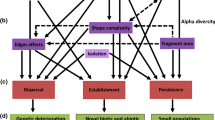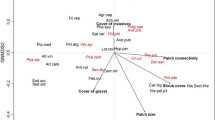Abstract
Context
Landscape fragmentation significantly affects species distributions by decreasing the number and connectivity of suitable patches. While researchers have hypothesized that species functional traits could help in predicting species distribution in a landscape, predictions should depend on the type of patches available and on the ability of species to disperse and grow there.
Objectives
To explore whether different traits can explain the frequency of grassland species (number of occupied patches) and/or their occupancy (ratio of occupied to suitable patches) across a variety of patch types within a fragmented landscape.
Methods
We sampled species distributions over 1300 grassland patches in a fragmented landscape of 385 km2 in the Czech Republic. Relationships between functional traits and species frequency and occupancy were tested across all patches in the landscape, as well as within patches that shared similar management, wetness, and isolation.
Results
Although some traits predicting species frequency also predicted occupancy, others were markedly different, with competition- and dispersal-related traits becoming more important for occupancy. Which traits were important differed for frequency and occupancy and also differed depending on patch management, wetness, and isolation.
Conclusions
Plant traits can provide insight into plant distribution in fragmented landscapes and can reveal specific abiotic, biotic, and dispersal processes affecting species occurrence in a patch type. However, the importance of individual traits depends on the type of suitable patches available within the landscape.





Similar content being viewed by others
References
Beals EW (1984) Bray–Curtis Ordination—an effective strategy for analysis of multivariate ecological data. Adv Ecol Res 14:1–55
Bossuyt B, Honnay O (2006) Interactions between plant life span, seed dispersal capacity and fecundity determine metapopulation viability in a dynamic landscape. Landscape Ecol 21(8):1195–1205
Cadotte MW, Mehrkens LR, Menge DNL (2012) Gauging the impact of meta-analysis on ecology. Evol Ecol 26:1153–1167
Cornelissen JHC, Lavorel S, Garnier E, Diaz S, Buchmann N, Gurvich DE, Reich PB, ter Steege H, Morgan HD, van der Heijden MGA, Pausas JG, Poorter H (2003) A handbook of protocols for standardised and easy measurement of plant functional traits worldwide. Aust J Bot 51:335–380
Cornwell WK, Ackerly DD (2010) A link between plant traits and abundance: evidence from woody plants in coastal California. J Ecol 98:814–821
de Bello F, Berg MP, Dias ATC, Diniz-Filho JAF, Götzenberger L, Hortal J, Ladle RJ, Lepš J (2015) On the need for phylogenetic ‘corrections’ in functional trait-based approaches. Folia Geobot 50(4):349–357
de Bello F, Fibich P, Zelený D, Kopecký M, Mudrák O, Chytrý M, Pyšek P, Wild J, Michalcová D, Sádlo J, Šmilauer P, Lepš J, Pärtel M (2016) Measuring size and composition of species pools: a comparison of dark diversity estimates. Ecol Evol 6(12):4088–4101
Diniz-Filho JAF, Bini LM, Rangel TF, Morales-Castilla I, Olalla-Tarraga MA, Rodriguez MA, Hawkins BA (2012) On the selection of phylogenetic eigenvectors for ecological analyses. Ecography 35:239–249
Durka W, Michalski SG (2012) Daphne: a dated phylogeny of a large European flora for phylogenetically informed ecological analyses. Ecology 93:2297
ESRI (2011) ArcGIS Desktop, Release 10. Documentation manual. Environmental Systems Research Institute, Redlands
Ewald J (2002) A probabilistic approach to estimating species pools from large compositional matrices. J Veg Sci 13:191–198
Hanski I (1994) Patch-occupancy dynamics in fragmented landscapes. Trends Ecol Evol 9(4):131–135
Helsen K, Hermy M, Honnay O (2013) Spatial isolation slows down directional plant functional group assembly in restored semi-natural grasslands. J Appl Ecol 50:404–413
Hemrová L, Münzbergová Z (2012) Identification of suitable unoccupied habitats: direct versus an indirect approach. Preslia 84:925–937
Herben T, Suda J, Klimešová J, Mihulka S, Riha P, Simova I (2012) Ecological effects of cell-level processes: genome size, functional traits and regional abundance of herbaceous plant species. Ann Bot 110:1357–1367
Jacquemyn H, Butaye J, Hermy M (2003) Influence of environmental and spatial variables on regional distribution of forest plant species in a fragmented and changing landscape. Ecography 26:768–776
Janeček Š, de Bello F, Horník J, Bartoš M, Černý T, Doležal J, Dvorský M, Fajmon K, Janečková P, Jiráská Š, Mudrák O, Klimešová J (2013) Effects of land-use changes on plant functional and taxonomic diversity along a productivity gradient in wet meadows. J Veg Sci 24(5):898–909
Johansson VA, Cousins SAO, Eriksson O (2011) Remnant populations and plant functional traits in abandoned semi-natural grasslands. Folia Geobotanica 46:165–179
Jongejans E, Telenius A (2001) Field experiments on seed dispersal by wind in ten umbelliferous species (Apiaceae). Plant Ecol 152:67–78
Kleyer M et al (2008) The LEDA Traitbase: a database of life-history traits of the Northwest European flora. J Ecol 96:1266–1274
Kleyer M, Dray S, Bello F, Lepš J, Pakeman RJ, Strauss B, Thuiller W, Lavorel S (2012) Assessing species and community functional responses to environmental gradients: which multivariate methods? J Veg Sci 23:805–821
Klimeš L, Klimešová J, Hendriks R, van Groenendael J (1997) Clonal plant architecture: Comparative analysis of form and function. In: van Groenendael HKJ (ed) The ecology and evolution of clonal plants. Backhuys Publishers, Leiden, pp 1–29
Klimešová J, de Bello F (2009) CLO-PLA: the database of clonal and bud bank traits of Central European flora. J Veg Sci 20:511–516
Klimešová J, Latzel V, de Bello F, van Groenendael J (2008) Plant functional traits in studies of vegetation changes in response to grazing and mowing: towards a use of more specific traits. Preslia 80:245–253
Klimešová J, Janeček Š, Horník J, Doležal J (2011) Effect of the method of assessing and weighting abundance on the interpretation of the relationship between plant clonal traits and meadow management. Preslia 83:437–453
Klotz S, Kühn I, Durka W (eds) (2002) BIOLFLOR—Eine Datenbank zu biologisch-ökologischen Merkmalen der Gefäßpflanzen in Deutschland. Schriftenreihe für Vegetationskunde 38. Bundesamt für Naturschutz, Bonn
Koyanagi T, Kusumoto Y, Yamamoto S, Okubo S, Iwasaki N, Takeuchi K (2012) Grassland plant functional groups exhibit distinct time-lags in response to historical landscape change. Plant Ecol 213:327–338
Leishman MR, Wright IJ, Moles AT, Westoby M (2000) The evolutionary ecology of seed size. In: Fenner M (ed) Seeds—the ecology of regeneration in plant communities, vol 2. CAB International, Wallingford, pp 31–57
Lewis RJ, de Bello F, Bennett JA, Fibich P, Finerty GE, Götzenberger L, Hiiesalu I, Kasari L, Lepš J, Májeková M, Mudrák O, Riibak K, Ronk A, Rychetská T, Vítová A, Pärtel M (2016) Applying the dark diversity concept to nature conservation. Conserv Biol 31:1–8
Lindborg R, Eriksson O (2004) Historical landscape connectivity affects present plant species diversity. Ecology 85:1840–1845
Maurer K, Durka W, Stocklin J (2003) Frequency of plant species in remnants of calcareous grassland and their dispersal and persistence characteristics. Basic Appl Ecol 4:307–316
McGarigal K, Cushman SA, Neel MC, Ene E (2002) FRAGSTATS: spatial pattern analysis program for categorical maps. Computer software programme produced by authors. University of Massachusetts, Amherst
McIntyre S, Lavorel S, Tremont RM (1995) Plant life-history attributes—their relationship to disturbance responses in herbaceous vegetation. J Ecol 83:31–44
Michalcová D, Chytrý M, Pechanec V, Hájek O, Jongepier JW, Danihelka J, Grulich V, Šumberová K, Preislerová Z, Ghisla A, Bacaro G, Zelený D (2013) Diversity of grasslands in a landscape context: a comparison of contrasting regions in Central Europe. Folia Geobot 49:117–135
Mueller-Dombois D, Ellenberg H (1974) Aims and methods of vegetation analysis. Wiley, New York
Münzbergová Z, Herben T (2004) Identification of suitable unoccupied habitats in metapopulation studies using co-occurrence of species. Oikos 105:408–414
Ozinga WA, Hennekens SM, Schaminee JHJ, Bekker RM, Prinzing A, Bonn S, Poschlod P, Tackenberg O, Thompson K, Bakker JP, van Groenendael JM (2005a) Assessing the relative importance of dispersal in plant communities using an ecoinformatics approach. Folia Geobot 40:53–67
Ozinga WA, Schaminee JHJ, Bekker RM, Bonn S, Poschlod P, Tackenberg O, Bakker J, van Groenendael JM (2005b) Predictability of plant species composition from environmental conditions is constrained by dispersal limitation. Oikos 108:555–561
Pärtel M, Szava-Kovats R, Zobel M (2011) Dark diversity: shedding light on absent species. Trends Ecol Evol 26:124–128
Poorter H, De Jong R (1999) A comparison of specific leaf area, chemical composition and leaf construction costs of field plants from 15 habitats differing in productivity. New Phytol 143:163–176
R Development Core Team (2014) R: a language and environment for statistical computing. Vienna, Austria: R Foundation for Statistical Computing. Retrieved from http://www.R-project.org/
Riibak K, Reitalu T, Tamme R, Helm A, Gerhold P, Znamenskiy S, Bengtsson K, Rosén E, Prentice HC, Pärtel M (2014) Dark diversity in dry calcareous grasslands is determined by dispersal ability and stress-tolerance. Ecography. doi:10.1111/ecog.01312
Šmilauer P, Lepš J (2014) Multivariate analysis of ecological data using canoco 5. Cambridge University Press, Cambridge
Soons MB, Ozinga WA (2005) How important is long-distance seed dispersal for the regional survival of plant species? Divers Distrib 11:165–172
Soons MB, Heil GW, Nathan R, Katul GG (2004a) Determinants of long-distance seed dispersal by wind in grasslands. Ecology 85:3056–3068
Soons MB, Nathan R, Katul GG (2004b) Human effects on long-distance wind dispersal and colonization by grassland plants. Ecology 85:3069–3079
Tamme R, Götzenberger L, Zobel M, Bullock JM, Hooftman DAP, Kaasik A, Pärtel M (2014) Predicting species’ maximum dispersal distances from simple plant traits. Ecology 95:505–513
Thomson FJ, Moles AT, Auld TD, Kingsford RT (2011) Seed dispersal distance is more strongly correlated with plant height than with seed mass. J Ecol 99:1299–1307
Violle C, Navas ML, Vile D, Kazakou E, Fortunel C, Hummel I, Garnier E (2007) Let the concept of trait be functional! Oikos 116:882–892
Westoby M, Leishman M, Lord J (1996) Comparative ecology of seed size and dispersal. Philos Trans R Soc Lond Ser B 351:1309–1317
Acknowledgements
This research was funded by GAČR grant no. P505/12/1296 and GA16-12243S. We thank Karel Fajmon, Záboj Hrázský, Šárka Jiráská, and Josef Vozanka for field sampling, David Zelený for valuable comments on Beals smoothing calculations and Bruce Jaffee for English corrections.
Author information
Authors and Affiliations
Corresponding author
Electronic supplementary material
Below is the link to the electronic supplementary material.
Rights and permissions
About this article
Cite this article
Janečková, P., Janeček, Š., Klimešová, J. et al. The plant functional traits that explain species occurrence across fragmented grasslands differ according to patch management, isolation, and wetness. Landscape Ecol 32, 791–805 (2017). https://doi.org/10.1007/s10980-017-0486-y
Received:
Accepted:
Published:
Issue Date:
DOI: https://doi.org/10.1007/s10980-017-0486-y




